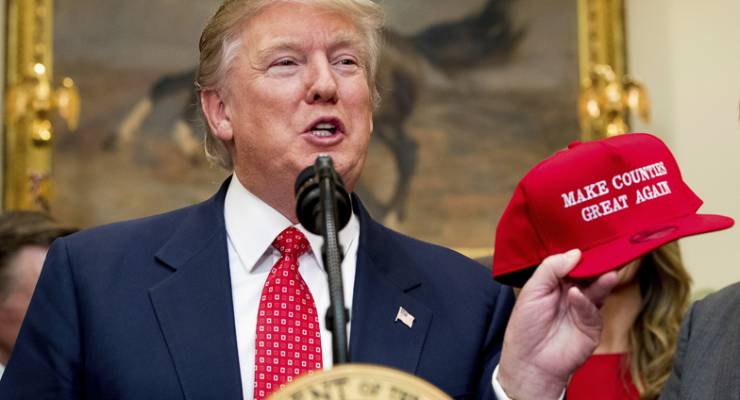
US president Donald Trump’s latest tweet claimed “The Stock Market has been creating tremendous benefits for our country in the form of not only Record Setting Stock Prices, but present and future Jobs, Jobs, Jobs …”
This is not only fake news, as are most Trump tweets, but potentially quite damaging.
Yes, the US economy is growing. But the whole world is now enjoying the strongest trade and corporate profits boom since World War II. The evidence suggests the US over the last year has been dragged along in the wake of the driver economies rather than taking the lead.
One easy way to assess Trump’s impact is to compare US global rankings before the change of government with after.
Value of the US dollar
Over the 12 months from the end of December 2016 to the end of December 2017, the US dollar has fallen relative to all major currencies, a pretty emphatic indication that the economy is much weaker than it was. These include the euro, the British pound, the Canadian dollar, the Swiss franc, the Japanese yen, the Chinese yuan, the Aussie dollar, the New Zealand dollar, the Russian ruble, the Indian rupee and the Mexican peso.
The dollar has risen, however, against the Bangladeshi taka and the Ugandan shilling.
Sharemarket rises
US sharemarkets surged in 2017. But so did almost all the world’s major stock exchanges. The Dow Jones industrial average increased 25.1%, which seems impressive. But with other indices enjoying much greater gains, it is implausible to credit the lift to Trump.
In fact, if we compare 10 key stock exchange indices* through 2016 and then through 2017, two intriguing facts emerge: the lift in the Dow Jones IA through 2016, under the Obama administration, was the highest of all these ten indices. The lift through 2017, under Trump, was the lowest.
Unemployment rate
The US jobless rate has continued the impressive decline which began with the stimulus packages in 2009 in response to the Great Recession. The December jobless rate of 4.1 per cent, ranks equal 47th in the world. Good, but not world-beating. Among the 35 rich, developed member-countries of the Organisation for Economic Cooperation and Development (OECD), that ranks tenth. Two years ago, although the rate was higher at 5.0%, that ranked ninth. Relative to the world, America is slipping.
Wage growth and inflation
The rate of wage growth slowed during 2017 to just 2.29%. The rise in calendar 2016 was 2.54% and the year before 2.56%.
Inflation through the year to November, the latest number, was 2.2%. Hence no real pay increase under Trump. In 2016, inflation to November was 1.7% and the year before 0.5%. Workers received significant real wage increases in those two years.
Tourist arrivals
Probably the most embarrassing statistic for the Trumpistas is the slump in tourist arrivals to the USA at a time when global tourism numbers are at all-time records.
For the year to July 2017, arrivals are just 19.92 million, which is 6.4% below the same period in 2016, and well below the equivalent levels for 2015 and 2014.
Balance of trade
The trade deficit in the US deepened to $50.5 billion in November 2017. One year earlier, in November 2016, the deficit was just $46.4 billion. That’s a deterioration of almost 9%.
The current deficit is the deepest since January 2012, nearly six years ago.
Government debt
Trump claimed credit for the decline in debt through his early months, despite advice that this was due to pre-existing policies.
That changed suddenly in September, when government debt blew out by a staggering $400.4 billion. More was added in October and November. Over the full year, debt increased by $516 billion. That’s more than the entire debt Australia and New Zealand have accumulated since they became countries.
The looming danger of household debt
Trump also bragged in a recent tweet that Christmas sales were the best ever. We don’t know if that is true. The data is still some way away.
Even if correct, household savings are now at a long-term low and debt is at a long-term high. Household savings for the third quarter in 2017 were just $478.3 billion, the lowest level since Q3 2008 at the depths of the Great Recession.
The September 2017 savings were a staggering 29.4% below the same quarter in 2016.
If Americans are now spending money they don’t have in the false belief that the good times are here – or about to arrive – when the opposite is the case, that is a recipe for disaster.
*New York’s Dow Jones industrial average, Hong Kong’s Hang Seng, Japan’s Nikkei 500, FTSE China A 50, Mumbai’s Nifty 50, Turkey’s BIST all shares, Nigerian all shares, Nairobi all shares, Philippines’ PSEi composite, Chile’s IGPA select.








Oh well, only 3 years to go.
As always Alan . . . other side of the coin; restores balance and perspective. Appreciated.
Thank you Alan for a few ‘facts’. Beats fake news every time!!
As usual, AA’s lucid style and laser perspicacity is a joy to behold, a worthy model since the retirement of Mega George.
Thank you very much – another keeper in my Word.docs.